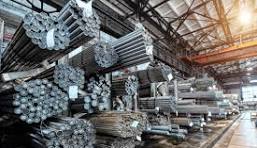Description
Steel is an alloy primarily made of iron (Fe) and carbon (C), where carbon typically makes up between 0.02% and 2.14% of the weight. This combination significantly improves the strength and durability of iron. Steel may also contain other alloying elements like manganese, chromium, nickel, or vanadium, depending on the desired properties (such as corrosion resistance, hardness, or flexibility).
Steel is widely used in construction, automotive, aerospace, machinery, shipbuilding, tools, and household appliances due to its strength, ductility, and versatility.
Steel can be categorized in several ways, but the two most common are by carbon content and by alloy composition. Here’s an overview:
Carbon Steel: This is the most commonly used type and is categorized based on its carbon content.
Low Carbon Steel (Mild Steel) – 0.05–0.25% carbon
Uses: Beams, structural shapes, auto panels
Features: Ductile, weldable, relatively weak
Medium Carbon Steel – 0.25–0.60% carbon
Uses: Railway tracks, gears, crankshafts
Features: Stronger, less ductile, heat-treatable
High Carbon Steel – 0.60–1.5% carbon
Uses: Cutting tools, springs, high-strength wires
Features: Very hard and strong, brittle if not tempered
Alloy Steel: Contains additional elements to enhance properties.
Common alloying elements: Chromium, nickel, molybdenum, vanadium, silicon
Uses: Pipelines, power turbines, automotive parts
Features: Improved strength, toughness, corrosion resistance, and wear resistance
Stainless Steel: Contains at least 10.5% chromium, which gives it corrosion resistance.
Austenitic (non-magnetic) – Most common, contains nickel and chromium
Uses: Kitchenware, medical equipment, chemical processing
Features: Highly corrosion-resistant, ductile
Ferritic (magnetic) – Less ductile, lower nickel
Uses: Automotive trim, appliances
Features: Good corrosion resistance, cheaper
Martensitic – High carbon content
Uses: Surgical instruments, knives
Features: Hard, strong, but less corrosion-resistant
Tool Steel: Specifically designed for making tools. Contains tungsten, molybdenum, cobalt, and vanadium.
Uses: Drills, cutting tools, molds, dies
Features: Hard, resistant to abrasion, retains shape at high temperatures
The global steel market is undergoing a transformative phase, driven by accelerating urbanization, infrastructure development, and industrial expansion. Valued at USD 16.24 billion in 2024, the global steel market is projected to grow to USD 27.84 billion by 2025 and reach an impressive USD 53.48 billion by 2033.
This growth, occurring at a compound annual growth rate (CAGR) of 8.50%, underscores the increasing importance of steel as a critical material in global economic development. Within this context, Nigeria stands at a pivotal point, endowed with abundant iron ore reserves and a growing domestic demand for steel, yet constrained by a persistent production-consumption imbalance.
Nigeria’s steel consumption was approximately 6.5 million metric tons in 2020. This figure is expected to rise to nearly 10 million metric tons annually due to the country’s rapid population growth, urban expansion, and ambitious infrastructure programs such as road construction, rail development, and housing.
However, domestic steel production continues to lag far behind, making Nigeria heavily dependent on imports to satisfy demand. This imbalance represents a substantial economic leakage and a lost opportunity for local industrialization and job creation.
Nigeria’s untapped iron ore reserves are estimated at over 3 billion metric tons, concentrated mainly in states like Kogi, Enugu, Niger, Zamfara, and Kaduna. The Itakpe iron ore deposit in Kogi State is one of the most prominent, long considered the bedrock of Nigeria’s steel ambitions. Other major sites include Agbaja, Ajabanoko, and the Lokoja-Bida belt.
Despite this abundance, iron ore mining in Nigeria remains underdeveloped. Activities are mostly artisanal or small-scale, with limited large-scale industrial exploitation. Several challenges—such as inadequate infrastructure, weak regulatory enforcement, limited investment, and inconsistent government policies—have constrained the development of a vibrant mining sector.
Carbon steel, which constitutes the majority of global steel production, is made by combining iron with carbon and is used extensively in construction, transportation, and manufacturing. Nigeria’s current steel production capacity is significantly underutilized.
The Ajaokuta Steel Plant, which was conceived in the late 1970s to drive Nigeria’s industrial revolution, remains largely non-operational despite decades of investment. With a planned capacity of 1.3 million metric tons annually, its failure to function at scale has had a ripple effect across the entire steel value chain.
Meanwhile, Delta Steel Company (now Premium Steel and Mines Ltd.), along with private rolling mills like African Foundries, Kam Steel, and Dana Steel, rely heavily on imported billets for rebar and flat steel production. The dependence on foreign raw materials undercuts the potential cost savings and economic benefits of local production, keeping prices high and domestic output low.
The gap between Nigeria’s steel production and consumption is not just an industrial issue—it’s a strategic economic concern. Steel is the backbone of infrastructure development, a key component in the production of automobiles, pipelines, bridges, and high-rise buildings.
With the government investing heavily in transportation networks and housing, the demand for steel is bound to rise. By producing more steel locally, Nigeria can reduce its import bill, conserve foreign exchange, stimulate local industries, and create thousands of skilled and semi-skilled jobs.
Moreover, developing a local steel industry adds value to Nigeria’s natural resources, particularly iron ore, and enhances the country’s ability to participate meaningfully in regional and global value chains. With the African Continental Free Trade Area (AfCFTA) opening up new market opportunities, Nigeria could position itself as a steel production hub in West Africa.
The promise of Nigeria’s steel industry is tempered by persistent challenges:
Infrastructure Deficiencies: Poor road networks, inadequate rail connections (particularly from mines to processing plants), and unreliable electricity supply inflate operational costs and limit competitiveness.
Policy and Regulatory Uncertainty: Frequent changes in policy direction, bureaucratic bottlenecks, and lack of investor-friendly regulations deter long-term investment.
Funding Constraints: The capital-intensive nature of steel production requires substantial investment, which many local companies struggle to secure due to weak financial support systems.
Skilled Labor Shortage: There’s a lack of adequately trained personnel to operate complex steelmaking machinery and manage mining operations efficiently.
To bridge the production-consumption gap, Nigeria must implement a comprehensive strategy that involves:
Revitalizing Ajaokuta Steel Plant and fully operationalizing NIOMCO (National Iron Ore Mining Company) in Itakpe.
Enhancing infrastructure, particularly rail links between mining areas, steel plants, and ports.
Attracting private sector investment through public-private partnerships (PPPs) and investor-friendly policies.
Encouraging local beneficiation by mandating the processing of a certain percentage of iron ore domestically before export.
Developing technical skills through specialized training programs and partnerships with global metallurgical institutes.
Nigeria stands on the threshold of industrial transformation. The combination of abundant iron ore reserves and a growing steel market creates a unique opportunity to build a robust, self-sustaining steel industry. By aligning its mining policies, industrial strategy, and infrastructure development, Nigeria can reduce its dependence on imported steel, capture more value from its natural resources, and lay a strong foundation for sustainable economic growth.
In doing so, the country will not only meet domestic demand but also play a pivotal role in the broader African steel supply chain.


Reviews
There are no reviews yet.